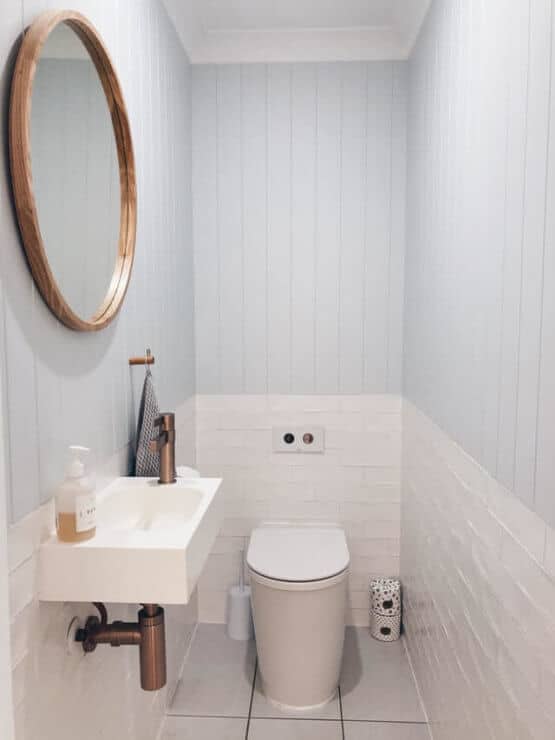Toilets can be sanitized in a variety of ways. However, because you’re attempting to save money, you can clean and sterilize your toilet with bleach. But does bleach damage toilet bowls?
Using bleach to clean the toilet may appear to be a great way to save time while also avoiding gloves, brushes, and cleaners. However, simply dropping that tablet in the toilet bowl could cause severe damage to your toilet.
Does Bleach Damage Toilet Bowls?
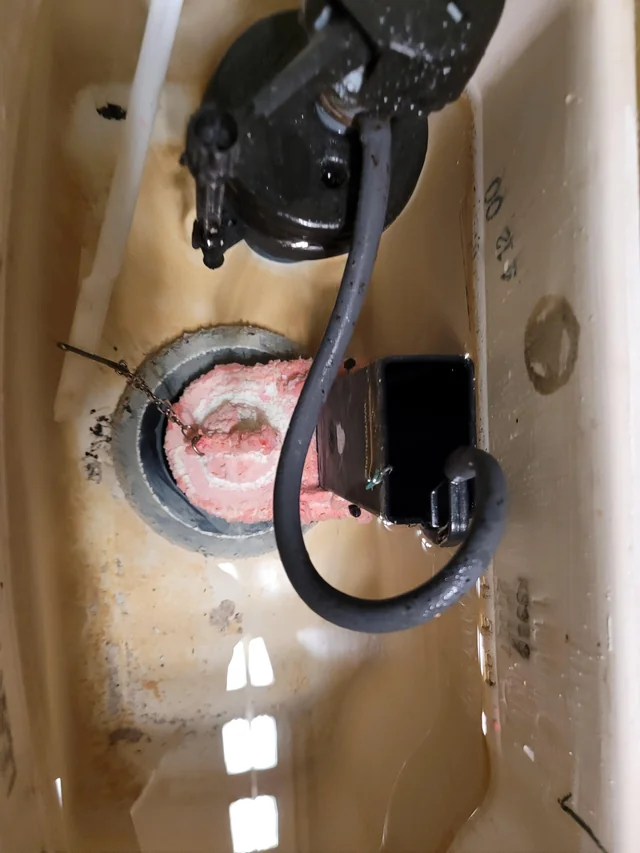
No, bleach won’t damage your porcelain toilet bowl. However, if you put bleach tablets into toilet tank, your toilet may be damaged over time. Bleach and other cleaning products are caustic, which slowly degrade weaker materials like rubber.
Bleach tablets can steadily deteriorate the rubber flapper inside your toilet, resulting in accidental water leaks and unnecessary repair costs.
The fasteners that hold the tank to the toilet bowl and the rubber gaskets between the bolts and the ceramic tank aren’t particularly strong. [1]
The rubber seals will degrade soon, while the bolts may take longer to disintegrate due to the bleach. In as little as six months, you may find yourself with rusty bolts and a leaking toilet, necessitating the replacement of the toilet to stop the leaks.
Related: Toilet Leaking Between Tank and Bowl
Cheap bleaching products cause blocked pipes
Another potential disadvantage of bleach tablets is that inferior ones can break apart over time rather than dissolve. Tiny tablet pieces can break off and get sucked into the toilet’s tiny passageways and stop the water from flowing.
While it will dissolve eventually, you may notice that your toilet does not flush appropriately for months at a time. The water may take a long time to fill the drain, or it may even trickle.
Related: How To Fix Weak Flushing Toilet
How Long to Leave Bleach In Toilet Bowl
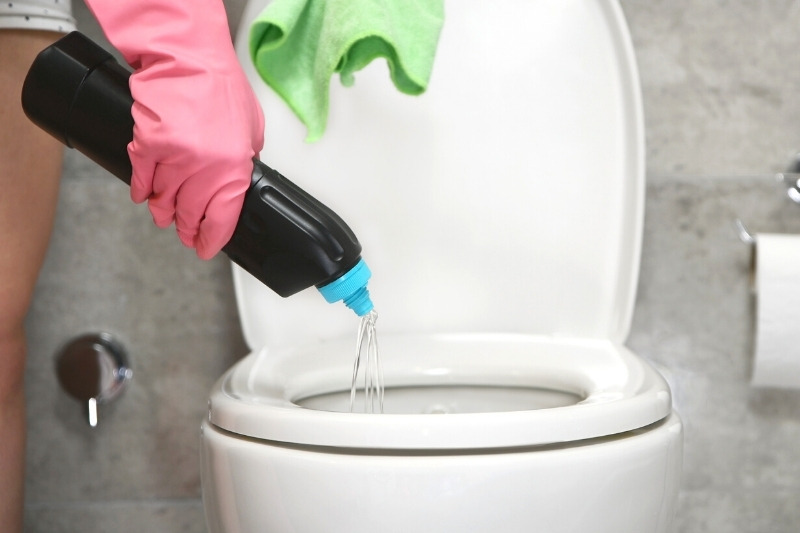
Bleach can be left in the toilet for up to 10 minutes. Then, pour between two and three cups of the suggested bleach into the clog and wait ten minutes for it to work.
Flush the toilet when the ten minutes have passed. You can continue this process and let it sit for another ten minutes before using your toilet brush to scrape it clean.
While it’s recommended to keep bleach in the toilet for around ten minutes, you can leave other cleansers there for as long as possible.
As a result, feel free to use any other toilet cleaner for as long as possible. The majority of individuals leave them in the toilet overnight. Based on your choices and needs, you may determine how long it can stay in the toilet.
Bleach is a little different in how long you should leave it in the toilet because it might make you sick and cause you to cough. When adding bleach to your toilet, you should also ensure there is no human waste in it.
Related: Black Streaks In Toilet
Is It Safe To Pour Bleach In Toilet Bowl?

Yes, if you dilute bleach with water, you can safely flush it down the toilet. The water helps to degrade the bleach into salt and water, making it biodegradable. If you’re hesitant to use bleach, consider using vinegar and baking soda to remove tough stains from your toilet bowl.
If your toilet has rust stains, don’t use bleach. This will result in the stains setting rather than being removed. Instead, apply 1/2 a cup baking soda to the rust and spray it with white vinegar to remove it. Before flushing, let it sit for about half an hour.
Because many toilets are designed with materials readily destroyed by bleach, you’ll need to contact the manufacturer to determine if it’s okay to flush bleach down the toilet.
Because bleach can irritate the eyes, skin, and lungs, you’ll want to take precautions, including wearing protective goggles and gloves as well as working in a well-ventilated area. Any regions of your skin that have come into touch with bleach should be washed right away.
Although bleach can clean your toilet bowl, it is not recommended for use in cleaning the outside of the toilet. [2]
This is because urine collects in such areas. And as the urine evaporates, ammonium salts are left behind. When bleach comes into contact with ammonia, a poisonous gas is generated.
If you must clean the outside of your toilet with bleach, clean it first with a light detergent and then sanitize it with a diluted bleach solution. After that, use a sponge and an all-purpose cleaner to wash out the surface.
Related: How To Remove Limescale From Toilet
Does Bleach Damage Toilet Bowls?
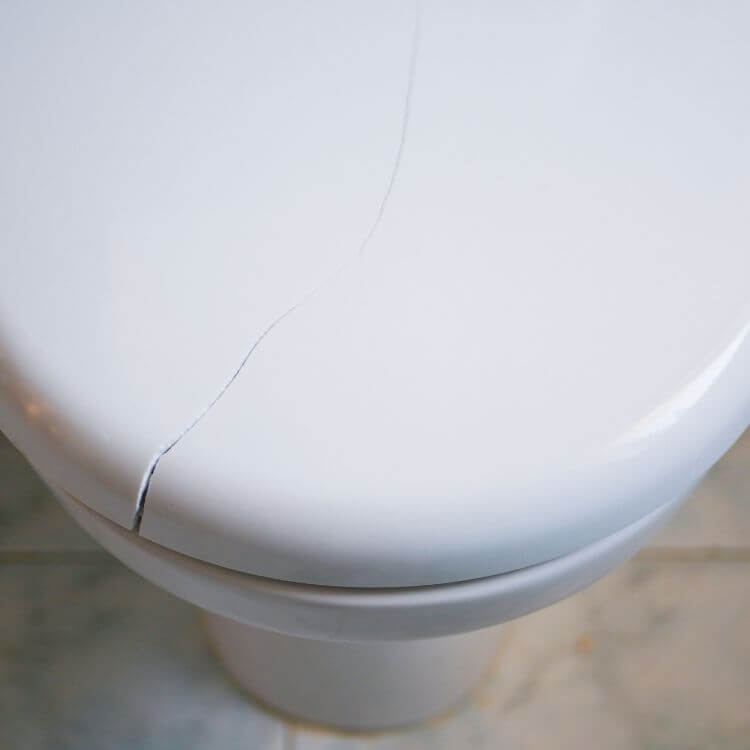
Yes, if bleach isn’t diluted with water, it can harm toilet bowls. While bleach usually is safe to use on porcelain and fireclay, it can oxidize the iron in an enamel toilet, causing rust stains to harden.
In addition, when bleach interacts with ammonia, a poisonous gas is produced.
Clean and sanitize the toilet bowl with chlorine bleach. Fill the toilet bowl with 12 cups of bleach and let it sit for 10 minutes.
After that, scrape the toilet thoroughly with a toilet brush before flushing. Mixing bleach and toilet bowl cleaners can result in the discharge of hazardous fumes.
Even the bleach chlorine products given to your toilet’s flush tank to clean and freshen it will erode the seals and cause them to leak. In addition, these products have the potential to harm the tank fitting, leaving it ineffective.
While bleach is a multipurpose cleaning chemical, it is inefficient in removing hard water stains.
However, if used in high concentrations, it can be dangerous—the suggested dosage for cleansing the toilet bowl is 500 parts per million, equivalent to two and a half teaspoons of ordinary household bleach per gallon of water. [3]
This concentration may appear modest, but it will complete the task without irritating the skin, eyes, or lungs. Just make sure you’re using bleach in its purest form—mixing it with other cleaning chemicals, particularly those that are ammonia-based, will result in toxic fumes and severe skin burns.
Related: How To Remove Rust From Toilet Bowl
Leaving bleach in the toilet overnight
You can keep the bleach in the toilet bowl overnight, but not longer. Bleach, as previously said, is a powerful cleaning agent that will corrode the toilet if left unattended for an extended period.
It’s okay to leave a tiny amount to absorb the stains overnight, but make sure your family is aware of the situation. Hence, no one urinates in the bleach water before flushing it down since this could result in suffocating fumes.
It’s also important to note that breathing bleach with a high quantity will make you sick. The stifling fumes may even cause you to cough your lungs out. Before using bleach to clean your toilet, ensure it’s free of urine.
Bleaches react strongly with ammonia and can cause severe burns if they come into touch with your skin. Worse, they’ll emit harmful fumes that could harm your lungs if you inhale them accidentally.
When handling bleaches, wear safety equipment and work in a well-ventilated area to avoid such incidents. Before using bleach, you should clean the toilet bowl with mild detergents.
For maximum effectiveness, leave any toilet bowl cleaner in the toilet overnight or for the whole weekend while you’re away. These detergents are gentle and will not damage your toilet even when you leave them for days. Sodium hypochlorite, generally known as bleach, is the main ingredient in commercial toilet bowl cleaners.
Commercial cleaners contain thickening ingredients that assist them to adhere to the slick surface, allowing the bleach to act on the stains.
Bleaches can be used to remove the slimy yuck that remains after the water has been drained. First, pour the bleach on it and let it do its work in your toilet. Then, pour out about one or two gallons of cold water into the tank until there is no more bleach.
In the meantime, bleach your bathroom at least once every week and sterilize your toilet brush with bleach once a month. Don’t forget to replace your toilet brush every six months, even if the bristles look in good shape.
Related: Does WD-40 Remove Hard Water Stains
Left bleach in the toilet too long
If you leave bleach in the toilet too long, the bleach gets to work, corroding the toilet gasket and seals and causing your toilet to fail.
What can I use instead of bleach to clean the toilet?
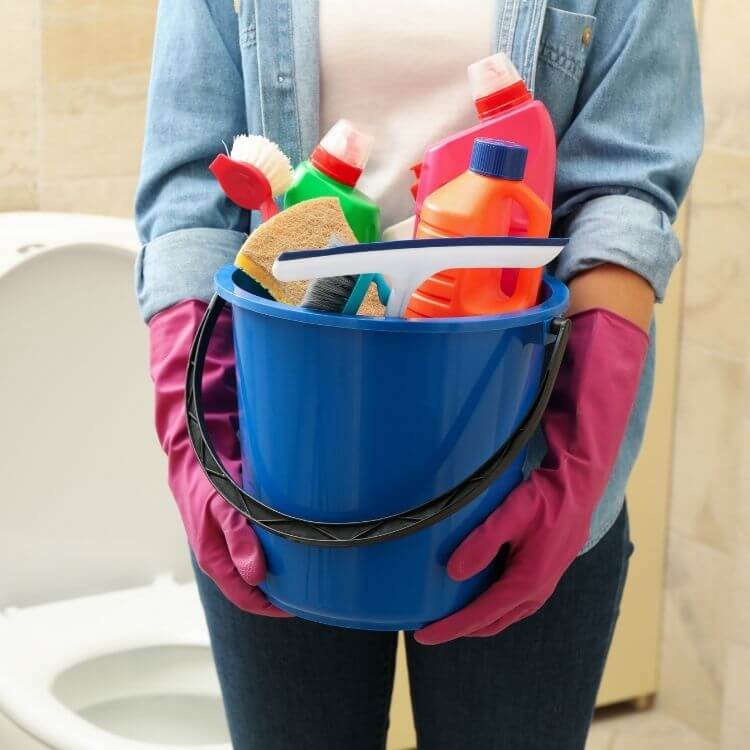
White vinegar disinfects just as well as bleach and is far safer to use; you can even spray it at full power. Apart from cleaning, vinegar’s acetic acid can eliminate mineral stains on the bowl’s sides if left in touch for an hour or two. Making a paste with vinegar and borax is one technique to keep it in contact.
First, spread the wet paste liberally on the interior of the bowl and mist it with vinegar as needed to keep it moist. Next, scrub the bowl with vinegar and rinse it with clear water after removing the paste and spots.
- The most hygienic way to clean the toilet
Sodium hypochlorite, also referred to as bleach, is the principal ingredient in several commercial toilet bowl cleaners. [4]
The key distinction between cleaning with a commercial cleaner and cleaning with pure bleach is that it contains thickening agents to retain it on the slippery porcelain while the bleach works. Therefore, you don’t need bleach to clean your toilet; vinegar disinfects and eliminates stains more effectively than bleach.
- Make use of a low-concentration solution
Although bleach is a cleansing agent and a disinfectant, it will not remove mineral stains created by hard water. As a result, it can be deadly when used in high quantities. The recommended concentration for bathroom and toilet cleaning is 500 parts per million.
This quantity is equivalent to 2 1/2 tablespoons of regular 5.25 percent home bleach in a gallon of water. Although this might seem like a mild concentration, it will get the job done without harming your skin, eyes, or lungs. Always use bleach alone; mixing it with other cleaning products, particularly ammonia, can result in deadly fumes and severe skin burns.
Best Way To Clean Toilet Bowl
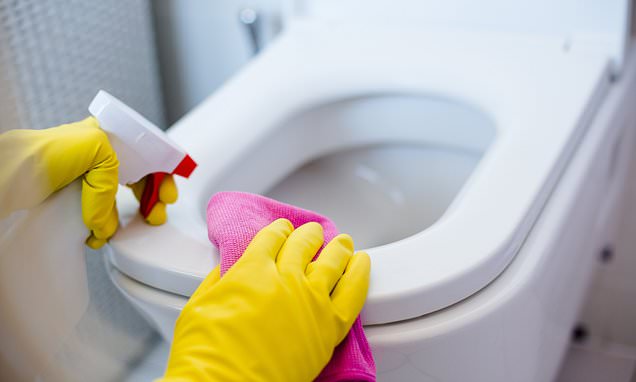
Put on rubber gloves and open the window to aerate the bathroom before cleaning the toilet bowl with bleach. Find a spray bottle and fill it halfway with water. Add sufficient domestic bleach to make a 500-part-per-million solution.
To ensure a bacteria-free toilet brush, soak it in the same bleach solution before using it. After flushing the toilet, clean the sides of the bowl, the bottom and top of the rim, and the seat.
Using clean water, rinse the places you washed, then spray the top and bottom of the seat and dry them down with a sponge. Rinse everything with clean water one last time.
Boost the Bleach Spray’s effectiveness
Although mixing bleach with acidic or alkaline cleaners is harmful, a drop of dish-washing soap can be safely added to the spray mixture. This aids the spray in removing stubborn urine stains and other deposits from the back of the rim and underneath the seat.
Scrub the porcelain and seat of your toilet bowl with baking soda before treating it with bleach if it hasn’t been cleaned in a while. Sodium bicarbonate is a gentle abrasive that cleans and deodorizes.
Use the bleach spray to deep clean and disinfect after thoroughly washing the baking soda off with plain water.
Read Also: Toilet Bowl Smells Like Urine
Conclusion
If you’ve ever wondered whether you can flush bleach down the toilet or not, the answer is yes. You can keep it in the toilet for up to ten minutes, but the duration is influenced by your aim. Also, make sure you don’t add bleach to your toilet when it’s full of urine. It’s advisable to flush the toilet before using bleach.
Read Next: Worms In Toilet

Michael Davis is a heating & plumbing expert who currently works as independent contractor in SC. He also writes for Plumbertip.
For almost 10 years he worked on various plumbing tasks across South Carolina.


